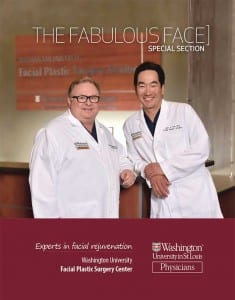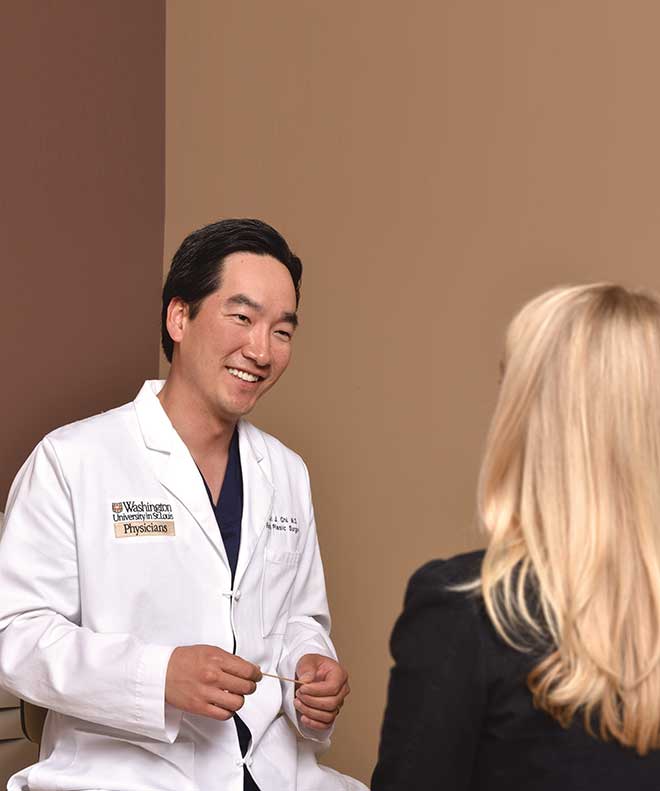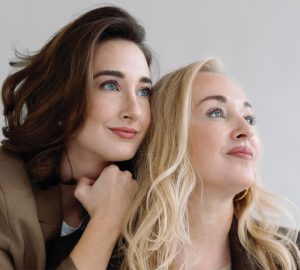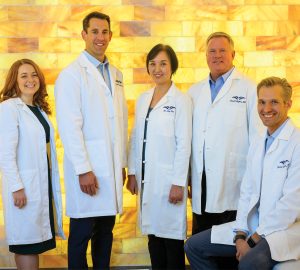It’s no surprise that noninvasive facial procedures are being widely embraced by patients. After all, we all want to look our best, yet we want to do it in the easiest and safest way. Minimal downtime and maximum benefits are what a new, FDA-approved injection therapy, Kybella, offers as the first nonsurgical remedy to combat fat under the chin.
 Dr. John Chi and Dr. Gregory Branham, both board-certified facial plastic surgeons at Washington University Facial Plastic Surgery Center, focus on procedures for the face and neck, ranging from Botox injections to facial reconstruction for trauma and cancer patients. “We’ve been tending toward more nonsurgical options because patients are hoping to maximize their benefits without going under the knife,” Chi says. Instead of coming in to talk about face-lifts and liposuction, they say most patients today opt for procedures like chemical peels, laser facial resurfacing and dermabrasion.
Dr. John Chi and Dr. Gregory Branham, both board-certified facial plastic surgeons at Washington University Facial Plastic Surgery Center, focus on procedures for the face and neck, ranging from Botox injections to facial reconstruction for trauma and cancer patients. “We’ve been tending toward more nonsurgical options because patients are hoping to maximize their benefits without going under the knife,” Chi says. Instead of coming in to talk about face-lifts and liposuction, they say most patients today opt for procedures like chemical peels, laser facial resurfacing and dermabrasion.
That has made the time ripe for Kybella, one of the latest noninvasive techniques specifically targeted for fat under the chin. The injection therapy is an alternative to traditional surgical options for this facial area, which include a neck lift, chin implant, mini lift, face-lift and liposuction. “To my knowledge, Kybella is the only FDA-approved nonsurgical treatment option for double chin,” Chi says. “Patients are getting good results, and they don’t have to invest a lot of time and energy into it.”
The average patient requires about two to four treatments. “This is one of the few procedures that when you’ve completed your treatments, you’re done,” Branham says. “It’s important to get it administered by a trained health care professional and wait two to three months between rounds to allow the treatment time to have its effects.”
Branham points out, however, that treatments must be matched to the right candidates. “With minimally invasive procedures, you’re looking at a specific population,” he says. “For Kybella, anyone with moderate fullness under the chin is a candidate.” For patients with jowls that are too large, eliminating the double chin would just accentuate the jowls, he says. Chi adds that an ideal candidate must also have good skin elasticity. “The molecules dissolve the fat that lives under the skin in the subcutaneous level, so that becomes empty space. A younger, reasonably healthy person can compensate with their skin’s elasticity because the skin will bounce back. But as you get older, your skin loses that ability.”
After the injections, patients will experience some swelling and inflammation of the area, which indicates the treatment is working, but nothing that should cause severe discomfort, the physicians say. “I even had one woman return to work right after the injections,” Chi says. Another patient who had been bothered by a double chin for years called her first treatment “smooth sailing,” other than some minimal pain and swelling. “It’s well worth the trade-off to avoid surgery,” she commented.
Chi and Branham point out that Kybella is just one tool in their toolbox. After a complete cosmetic consultation, if someone is not a good candidate, there are still options to get the desired results. “Patients are always looking for good results without a lot of downtime, and we are dedicated to offering the best treatment options available for each individual,” Chi says.
Dr. John Chi and Dr. Gregory Branham provide a range of noninvasive and surgical options for procedures of the face, head and neck, including the newly FDA -approved Kybella. Their practice, Washington University Facial Plastic Surgery Center, is at 1020 N. Mason Road, Ste. 205, in Creve Coeur on the Barnes-Jewish West County Hospital campus. For more information, call 314.996.3880 or visit facialplasticsurgery.wustl.edu.
Pictured above: Dr. John Chi
Pictured on the cover: Dr. Gregory Branham and Dr. John Chi
Photos Courtesy of Washington University Physicians
Cover design by Allie Bronsky








